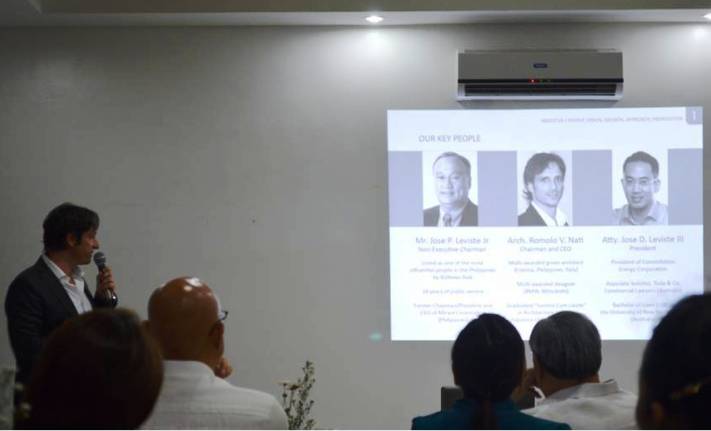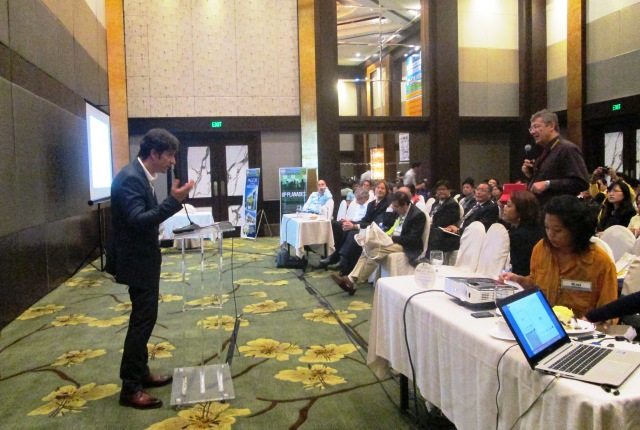Multi-awarded Italian architect offers to draft rehab master plan for typhoon-hit areas
MANILA – An Italian architect with an interest in green energy and sustainable architecture is offering to help draft the master plan to rebuild Leyte and other parts of Eastern Visayas hardest hit by super typhoon ‘Yolanda’.
Architect Romolo V. Nati, executive chairman and chief executive officer of ITPI (Italpina Euroasian Design and Eco-Development Corp.) said he is willing to work with local engineers in affected areas to build storm-resistant urban centers.
“I feel very sad for the Filipinos in Tacloban and Leyte who have to deal with the death and destruction brought by Yolanda, and I would like to help them get back on their feet,” said Nati, who has made the Philippines his adoptive home for four years now.
The Italian head of ITPI has partnered with Constellation Energy Corp (CEC),which has expanded its business from green energy to the design and development of sustainable buildings.
CEC has contracts with the Department of Energy (DOE) for several geothermal, wind and hydroelectric projects.
“Even as we grieve, we can move forward,” said Nati. “Now we have a chance to develop the master plans of the new cities and towns—sustainable plans that take into account the need to survive typhoons and build sustainable habitats.”
“It is possible to create master plans of cities and towns that have a much better chance of withstanding super storms and other extreme weather conditions that the world expects as a consequence of climate change,” he said.
Some features of sustainable habitats include proper zoning or concentrating living spaces in higher areas, in places 50 to 100 meters above sea level, and building dikes and storm walls, as well as drainage channels to facilitate the flow of storm waters into the sea.
“For buildings, we can also adopt what I call the ‘Aikido strategy,’ that includes adopting features that minimize the opposition of strong winds and storm waters,” Nati said. Aikido is a Japanese martial art in which practitioners don’t oppose their attackers head on but instead flow with the motion of the attacker to redirect the force of the attack.
Among these features are perforated facades and inner courtyards, both of which minimize the opposition of buildings to storm surges and strong winds brought by typhoons.
“Buildings can also be designed to withstand extreme conditions by adopting hydrodynamic and aerodynamic shapes,” Nati said.
“Of course building structures that are elevated from the ground will also help protect the building from flash floods during storms,” he said.
“For settlements along coastal areas, erecting buildings with all their load-bearing walls positioned perpendicular—and not in opposition—to the sea can help withstand tsunamis. Open room-to-room designs that minimize obstruction in the event of overpowering flow of water can also help,” he said.
Nati said these storm-resistant features have been incorporated in Tower 1 of the Primavera Residences, ITPI’s mixed-use condominium complex in Cagayan de Oro (CDO) City, and helped it survive the deadly typhoon Sendong that flattened many buildings in CDO and in nearby Iligan City in December 2011.
Nati’s work has been recognized by many organizations around the world and has won him many international competitions, including the 2011 Design Against the Elements (DAtE) International Design Competition sponsored by the National Geographic Society, the Climate Change Commission, and the United Architects of the Philippines (UAP) with other institutions.
His “Coral City Concept” bested 200 entries from 50 countries and bagged the Special Energy Award.
He graduated summa cum laude in architecture from the La Sapienza University in Rome and has a Masters in Urban Landscape and Layers from the University of Tallin in Estonia.
Published by Interaksyon.com
Italian wants to rebuild East Visayas with green technology
AN Italian architect with an interest in green energy and sustainable architecture wants to craft master plans to rebuild Leyte and other parts of Eastern Visayas that were hardest hit by Supertyphoon Yolanda
Nati, Executive Chairman and Chief Executive Officer of Italpinas Euroasian Design and Eco-Development Corp
(ITPI), is willing to work with local engineers in affected areas to build storm-resistant urban centers
The Italian head of ITPI has partnered with Constellation Energy Corp
, (CEC)which has expanded its business from green energy to the design and development of sustainable buildings
CEC has contracts with the Department of Energy for several geothermal, wind and hydroelectric projects
The plan includes proper zoning or concentrating living spaces in higher areas, in places 50 meters to 100 meters above sea level
On civil works component, he stressed the importance to build dikes and storm walls, as well as drainage channels to facilitate the flow of storm waters into the sea
“For buildings, we can also adopt what I call the ‘Aikido strategy,’ that includes adopting features that minimize the opposition of strong winds and storm waters,” Nati said
Aikido is a Japanese martial art in which practitioners don’t oppose their attackers head on but instead flow with the motion of the attacker to redirect the force of the attack
Among these features are perforated facades and inner courtyards, both of which minimize the opposition of buildings to storm surges and strong winds brought by typhoons
“Buildings can also be designed to withstand extreme conditions by adopting hydrodynamic and aerodynamic shapes,” he said
“Of course, building structures that are elevated from the ground will also help protect the building from flash floods during storms
”
For settlements along coastal areas, Nati said erecting buildings with all their load-bearing walls positioned perpendicular to the sea can help withstand tsunamis
“Open room-to-room designs that minimize obstruction in the event of overpowering flow of water can also help,” Nati said
These design features will ensure that while strong surges may damage the building its superstructure, at least, will survive to be restored and reused
Nati said these storm-resistant features have been incorporated in Tower 1 of the Primavera Residences, ITPI’s mixed-use condominium complex in Cagayan de Oro (CDO) City, and helped it survive the deadly Typhoon Sendong that flattened many buildings in CDO and in nearby Iligan City in December 2011
Published in the Business Mirror Dec
1, 2013
businessmirror
com
ph/index
php/en/news/regions/23659-italian-wants-to-rebuild-east-visayas-with-green-technology
Green building and sustainable architecture in a climate change-challenged world
YOLANDA REHABILITATION EFFORTS have attracted this Italian architect and expert on sustainable architecture and green building. He’s offering to contribute his skills to help rebuild Leyte and the other parts of Eastern Visayas that have been recently devastated by the super typhoon.
Watch how ITPI Corp. (ItalPinas Euroasian Design and Eco-Development) incorporates green building and sustainable architecture principles in its developments throughout the building life cycle.
http://www.slideshare.net/italpinas/itpi-sustainable-architecture-and-green-building
Watch a short video clip on how ITPI uses performance-based design software to design sustainable buildings: http://primaveraresidences.italpinas.com/using-performance-based-design-software-to-design-sustainable-buildings/
ITPI SOARS in green architecture design & construction

Primavera Residences recently partnered with BPI Family Savings Bank to conduct a Business and Investment Opportunity Forum. The event called Sustainable Opportunities and Advocacies in the Regions or SOAR was held last October 17, 2013 at the Multi-purpose Hall of Primavera Residences in Pueblo Business Park, Cagayan de Oro City.
Among the topics discussed during the event was “ITPI Green Architecture Design and Construction: The Primavera Residences Experience”. The talk was conducted by ITPI Executive Chairman and CEO Arch. Romolo Nati and he discussed not only what sets Primavera Residences apart from the rest, but also the importance of sustainable architecture.
Here are 10 key points of his discussion.
1. Inspired by nature. ITPI believes that nature holds the answer to sustainable design. Taking a cue from Mother Nature herself, the company strives to develop self-sustaining, flood-free, and earthquake-resistant structures which are inspired by the beauty and functionality of nature. These green structures fuse human technology with the best that nature has to offer.
2. Cross-disciplinary Approach. Primavera Residences is a brainchild of three strong forces: ITPI’s real estate ingenuity, CEC’s (Constellation Energy Corporation) renewable energy initiatives, and the expertise of RVN+ in Green Architecture and Design. The result? Beautiful, sustainable, and cost-effective designs.
3. Where no one has gone before. Primavera Residences, just like the rest of ITPI’s projects, offer a unique value proposition to its clients. With its eco-friendly design, unique innovations, prime location, and cost-efficient models, ITPI is leading the market in sustainable development.
4. The impact of real estate on the environment. Arch. Nati pointed out that the world’s cities occupy only 2% of the Earth’s land area, and yet it accounts for 70% of harmful greenhouse gas emissions. At the rate we are going, it is expected that by 2030, 59% of the world’s population will be living in urban areas, and by the year 2050, the consumption of energy for cooling will be grow tenfold. Increased energy consumption could lead to an increase in carbon dioxide emissions which will eventually lead to climate change and environmental degradation. Real estate development plays a big role in this, making sustainable architecture a necessary long-term solution.
5. Human resource consumption versus nature. Relying too much on technology coupled with our misconception that we have unlimited resources – this has led to the rapid deterioration of our environment. Where our cities once adapted to the local environment, we now manipulate our environment to adapt to us, hence the big change. To become sustainable, we need to reverse this mindset and change our perspective. We need to go back to nature.
6. Nature as the solution. There are patterns which can be found behind natural living structures. These processes, when studied and thoroughly examined can be translated into architectural designs and sustainable solutions. This is known as biomimicry and it has long been in existence, but has simply been overlooked amid all the new ways of doing things. Making nature as the basis of design allows ITPI to lower energy and resources consumption thereby reducing costs on electricity and water, among others.
7. Performance-based design process. While the traditional way of doing things calls for low tech design and high tech construction, ITPI does the exact opposite with high tech design and low tech construction. This result to lower cost and maintenance as well as low power requirement.
8. Environmental Analysis Tools. To aid ITPI in harnessing the power of nature, different software programs are being used. The different analysis involved include calculations for sunlight hours, wind patterns, and internal daylight. This is a great example of technology working hand in hand with nature.
9. ITPI Projects. Taking inspiration from the beauty and efficient design found in nature, the completed and upcoming projects of ITPI are of stellar quality and are highly-recognized internationally. These projects include Coral City (Quezon City), Stellar of Light (Payatas, QC), Sto. Tomas (Batangas), and of course, their pet project, Primavera Residences in Cagayan de Oro City which has already sold 188 units in a span of three years.
10. Why go green? Green properties are appraised 10 – 15% higher than its non-green counterparts, retail sales of eco-friendly buildings are higher by 20%, and they sell twice as fast as conventional homes. Therefore, not only are you doing your share in helping reduce environmental degradation, it is also so much more profitable and beneficial in the long run.
Italpinas’ award-winning designs and innovations are all based on ideas drawn from nature, coupled with the foresight, vision, and creativity of the people behind it. For example, did you know that the concept behind Cagayan de Oro’s very own Primavera Residences was actually based on the ventilation system found inside a termite’s mound?
Want to know more about CDO’s first and only eco-friendly building? Go HERE.
Green building expert ITPI to builders: adopt ‘biomimicry’ to build smarter, sustainable cities
Adopting the principle of biomimicry and undertaking performance-based design strategies — these are the keys to building sustainably in an environmentally challenged world.
That was the advice of an Italian architect and expert on green building and sustainable agriculture to builders, urban planners, government officials and various other advocates of sustainable development who attended the 2013 International Conference on Smarter Cities held last November 14 to 15 at the Diamond Hotel in Manila.
“By studying the process behind the creation of natural living structures, we are able to find patterns, which transform into design models needed to define architectural solutions,” said architect Romolo V. Nati, Executive Chairman and CEO of the ITALPINAS Euro Asian Design and Eco-Development Corporation (ITPI).
ITPI is a young developer that specializes in the design and development of sustainable buildings. Formed by Nati in 2009 in partnership with Filipino lawyer Jojo Leviste, ITPI invests most of its resources into an in-house research and design (R&D) department that studies sustainable architecture, as well as building in extreme conditions and challenging environments. ITPI is an affiliate of the renewable energy firm Constellation Energy Corp.

Adopting biomimicry — or the intersection of biology and technology — allows architects and builders to put up buildings that use water, energy and other resources efficiently, Nati said, even as he notes that the concept isn’t new and has long been used by the global defense industry.
Nati’s advice was part of his presentation titled “Eco-logic Architecture: Conceptualizing Buildings Differently,” which was given during one of five presentations under the theme Smarter Economy. The presentations were given during parallel sessions on the second day of the conference.
“Becoming sustainable requires a change in perspective,” Nati said. “We need to move from too much reliance on technology and from an inability to more adaptation to the local environment.”
The architect said this is needed because cities occupy only two percent of the world’s land mass but these account for 70 percent of harmful greenhouse gas emissions.
Nati noted: “Right now air conditioning in buildings worldwide consumes 1 trillion kilowatt-hours of electricity each year and by 2050, global consumption of energy for cooling could explode tenfold.”
“Increased CO2 emissions lead to increased energy consumption, which lead to climate change and environmental degradation,” he warned.
He said the solution was to follow nature and adapt more to the local environment by using local material and tapping local know-how when putting up buildings or other developments. He also advised sourcing power locally. “These wouldn’t only be a sustainable practice, but would also lower power requirements, as well as building and maintenance costs,” Nati said.
Performance-based strategies
Nati also recommended that architects and developers use the performance-based strategies that his company employs.
These include sunlight angle calculations for spatial planning optimization, wind analysis for spatial planning optimization and selective daylight internal computation for spatial planning optimization — all done by specialized software.
Organized by the University of the Philippines School of Urban and Regional Planning, the 2013 International Conference on Smarter Cities aimed to begin the public discourse on creating smarter cities in a world beset by overpopulation, rapid population growth, dwindling resources, widespread pollution, climate change and unrestrained urbanization.
The conference brought together builders, developers, engineers, planners and advocates of smart cities from across the world, who shared the ways that smarter technologies can be leveraged to improve the quality of life in cities.
Parallel sessions on six different main themes were held on the second day of the Conference:
- Smarter Governance
- Smarter Economy
- Smarter Mobility
- Smarter Environment
- Smarter Planning and Design and
- Smarter People and Living
Some of the more interesting presentations during the conference were:
- “Project NOAH: Importance of Technology in Mitigating Hazards” by Mahar A. Lagmay of the UP- National Institute of Geological Sciences for Smarter Governance.
- “Biofied Space Design – Toward Future Architectural Material, Energy and Integrated Information” by Akiko Watanabe of the Tokyo Denki University, Japan and “Smarter Urban Greening: The Philippine Context” by Arch. Paulo Alcazaren of PGAA Creative Design, Philippines / Singapore and “Landscape Architecture Trends in the Philippines: Ecological Planning as an Approach to the Sustainable Development of Disaster-Prone Sites” by Mary Ann Espina of the UP College of Architecture for Smarter Planning and Design.
- “Smarter Money for Smarter Cities” by Felix Fuders of the Universidad Austral de Chile for Smarter Economy
- “Urban Development and Groundwater Management in Asian Cities” by Karen Ann B. Jago-on, UP-SURP and “Planning City Extensions: An Approach to Achieving Sustainable Urban Development” by Christopher Rollo of the United Nations – Human Settlements Programme, Philippines for Smarter Environment
- “DOST’s Smarter Health Care Program” by Jaime C. Montoya, Department of Science and Technology – Philippine Council for Health Research and Development for Smarter People and Living
Italpinas to discuss green building, sustainable development at CTI-PFAN Forum 2013

ITALPINAS Euro Asian Design and Eco-Development Corporation (ITPI), a company involved in real estate investment development, architectural and design eco services, will discuss sustainable and green building at the upcoming CTI-PFAN Philippines Clean Energy Financing Forum 2013.
The forum, organized by the Climate Technology Initiative’s Private Financing Advisory Network, will be held on November 21 at the Isabela Ballroom of the Makati Shangri-la.
Fast becoming a leader in sustainable development and green building technologies, ITPI will also discuss its ongoing green developments, including Primavera Residences, a 10-storey condominium in Cagayan de Oro City.
Primavera incorporates several sustainable features, including a portion of its energy needs sourced from solar panels found on its roof, as well as a geo-cooling system and a shadow-cooling system, among others.
Italian architect Romolo V. Nati, ITPI’s Executive Chairman and Chief Executive Officer will speak about these features during session four of the forum, which focuses on sustainable business models.
Other sessions will tackle:
- Increasing the competitiveness of the sugar milling sector by adopting energy efficiency and renewable energy
- Improving the livestock sector by promoting biogas to meet national wastewater regulations, lower the cost of meat production by using electricity generated from livestock waste and develop additional revenue streams like organic fertilizer production
During the forum, the Electric Vehicle Expansion Enterprises, Inc. (EVEEI) will also present its electric jeepney operations as one sustainable business model, while Strategen Consulting LLC will speak about its waste management solution for the fruit processing sector as another sustainable business model.
Supported by the U.S. Agency for International Development (USAID), CTI-PFAN is a global program dedicated to helping clean energy project developers find sources of financing.
Thus, one forum session will also involve how start-ups can tap sources of clean energy financing — including Ayala Foundation and USAID’s Development Credit Authority — as well as complementary financing schemes appropriate for each stage of a company’s maturity.
The Forum will provide a networking space for one-on-one meeting sessions with clean energy project developers, financing institutions, investors, and other USAID programs.
For more details, contact:
Rex Darell B. Vergel
Senior Technical Analyst
CleanEnergy Solutions International
(formerly IRG Philippines)
Unit 2303 Medical Plaza Ortigas
25 San Miguel Ave., Ortigas Center
Pasig City, 1600 Philippines
E-mail: rexvergel@cleanenergy.com.ph
Phone/Fax: +63 2 910 3008
Mobile: +63 939 353 7695
Using performance-based design software to design sustainable buildings
Using performance-based design software to calculate sunlight angles, analyze wind analysis and compute selective daylight internal computation for spatial planning optimization. This is how ITPI Corp. (ItalPinas Euroasian Design and Eco-Development) does it.
On Mindanao News Daily: Primavera Residences Architect in Italian Language Week

Architect Romolo Valentino Nati, the Italian architect and designer who designed and executed Primavera Residences, Cagayan de Oro’s first ever eco-friendly mid-rise condominium, will be prominently featured in the 13th edition of the Settimana della lingua italiana (Italian Language Week) on December 10-13.
Arch. Nati has been invited to speak on “Eco-Friendly Buildings and Renewable Energy” on December 12 at the Conference on the theme: ““Ricerca, Scoperta, Innovazione: L’Italia dei saperi” (Research, Discovery, Innovation: Italy and Knowledge) at the Claro M. Recto Hall, Faculty Center (College of Arts and Letters), UP Diliman.
Continue reading story here.
DoE, Japan agencies hold talk on energy efficiency in buildings

(Taguig City) The Department of Energy (DOE), in cooperation with the Japan Business Alliance for Smart Energy Worldwide (JASE-W), ASEAN-Centre for Energy (ACE), and the Ministry of Economy, Trade, and Industry, Japan (METI), hosted a conference on energy efficient technologies that aimed to boost the implementation of energy efficiency in the building industry.
The “Conference on Energy Efficient Technologies in the Philippines (Business Sourcing and Matching Opportunities)” was held on 30 October 2013 at the Dusit Thani Manila, Makati City.
The said conference is part of the ASEAN-Japan Energy Efficiency Partnership (AJEEP), which seeks to establish cooperation on energy efficiency initiatives between the ASEAN and Japan.
Read more here.
– Media Group (DOE)
Featured on DOE.gov, 30 October 2013



